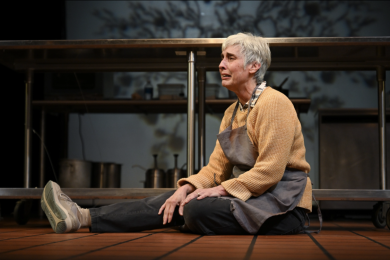Figuring out flight
The pull between what we really want in life and what we need to do to support ourselves might be best described with both magic and the mundane. Theatre Pro Rata fused these ideas by telling the story of a man who could fly — once, at least.
Up: The Man in the Flying Chair follows a nuclear Californian family in which the mother is a mail carrier, the son a dejected high school sophomore, and the father an inventor hung up on his one big feat. This character is based on the real-life inventor Larry Walters, who in 1982 launched a lawn chair into the sky by strapping balloons to it, spending a blissful few hours above the earth. The play makes clear that ever since that moment, he has spent his life chasing his dream of flight, or trying to figure out what else could possibly replace it. This has created some tension between the couple, with the mother financing the family’s life single-handedly while the father’s head remains (almost literally) in the clouds.
The family’s story is shaken up by imaginary appearances by Philippe Petit, the Frenchman who famously walked a wire between the World Trade Center’s Twin Towers. Throughout the play, he sets up a real wire two feet above Park Square Theatre’s Andy Boss Thrust Stage, and walks it to chiming music à la Amélie. These moments gave the play a dream-like quality that contrasted with another secondary plot: the son, Mikey, befriends a girl who’s pregnant and starts working for her aunt. Knowing them changes his outlook on the future, and sets him off against his father.
The cast gave the play the charm it needed. John Middleton imbued the inventor with lovable lostness and gentle humor. Shanan Custer skillfully walked the mother’s own wire between supportiveness and desperation. Playing the teen characters, Keegan Robinson and Lillie Horton held more than their own. At times, their story was less predictable and more fascinating than the rest.
Much like Petit on his walk up a slanted wire to the Eiffel Tower, this play had a lot of balancing to do. Its quirkiness tripped it up as it climbed toward insight about the struggle to go after goals. Having a tightrope walker and a pregnant teen share the stage was refreshing, but Max Lindorfer’s cartoon-style backdrop did not quite succeed at sketching them into the same world.
But the disjointed story did help illustrate the irrationality of trying to fly when the world we live in makes it tough enough to stay upright. Playwright Bridget Carpenter wrote, “people spend their whole lives looking for one thing they’re good at, that makes them special.” Her look at where each character was in their lives and in that search was compelling. Their collective successes and failures in following their ambitions, and the downfalls that came, were moving and somehow hopeful.


